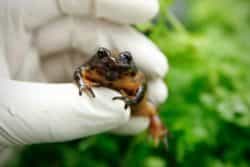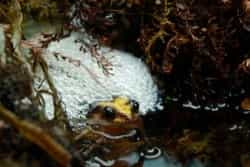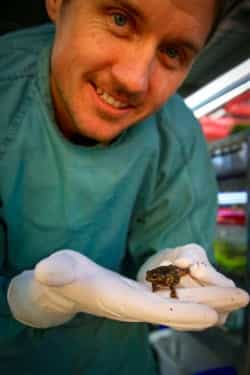Captive preservation

The Baw Baw Frog Recovery Program aims to restore the depleted population of the Baw Baw frog (Philoria frosti).
These amphibians live in a very cold, high altitude habitat upon Mt Baw Baw where they are important predators and prey – and from such specific requirements they are becoming increasingly rare, currently listed as critically endangered due to its population decline of 98% since 1980. Reports shockingly confirm there are only 1000 frogs left in the wild.

Image courtesy Zoo’s Victoria
The Baw Baw Frog thrives at an altitude of 1400m eating a carnivorous diet primarily of insects, worms and invertebrates.
At a size of 42-55m, the dark brown frog live in plateaus amongst cold spots in Victoria that are uninhabitable to most creatures. They are known to plant their eggs in natural soil cavities located underground, in which they lay their transparent eggs in a foam nest.
As the only indigenous frog of Victoria, it is of great importance to continue all conservation efforts to replenish the dwindling population of the Baw Baw frog.
The Baw Baw frog faces its primary threat of increased temperatures through the rise and tangible effects of climate change.
Other threats include the presence of the devastating Chytrid Fungus, historically killing other frogs such as the Southern Corroboree Frog.
In order to combat the threat of extinction, Zoos Victoria has collaborated with the Mt Baw Baw team by collecting egg masses from Mt Baw Baw to be raised in captivity.

Image courtesy Zoo’s Victoria
In order to encourage the breeding of the Baw Baw frog breeding bunkers were constructed in an attempt to simulate the species natural habitat.
With less than 1000 in the wild, the efforts of Melbourne Zoo’s conservation team are strong and continuous.
To support this mission, Melbourne Zoo Amphibian Specialist Damian Goodall has reportedly bred “speciality insects that are conducive to the female reproductive cycle” Mr Goodall said.
The team will “be releasing the majority of the eggs to Mt Baw Baw , but an insurance population of about 10 per cent will also be kept at Melbourne Zoo,” said Mr Goodall.

Image courtesy Zoo’s Victoria
Zoos Victoria would like to thank its Baw Baw Frog Recovery Program partners: Little Brown Things, Baw Baw Frog Recovery Team Baw Baw National Park, Baw Baw Shire Council, Deakin University, Department of Environment, Land, Water and Planning, Mt Baw Baw Alpine Resort and the University of Wollongong.




